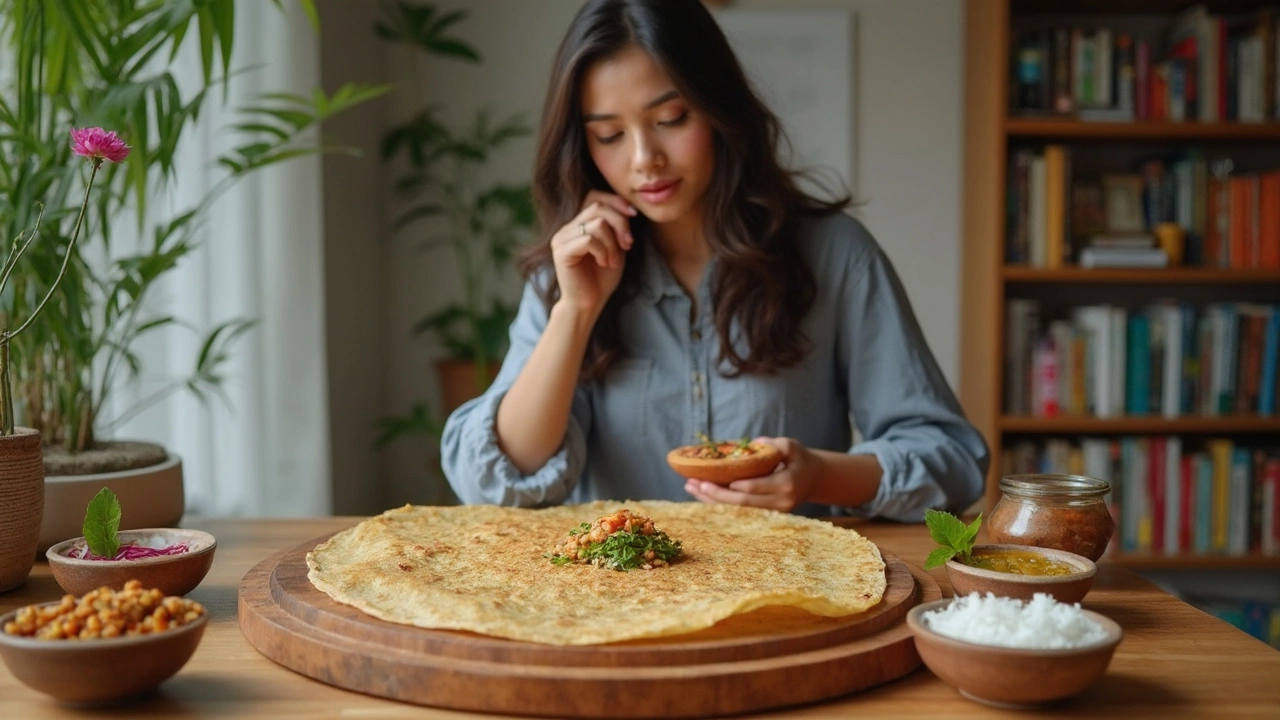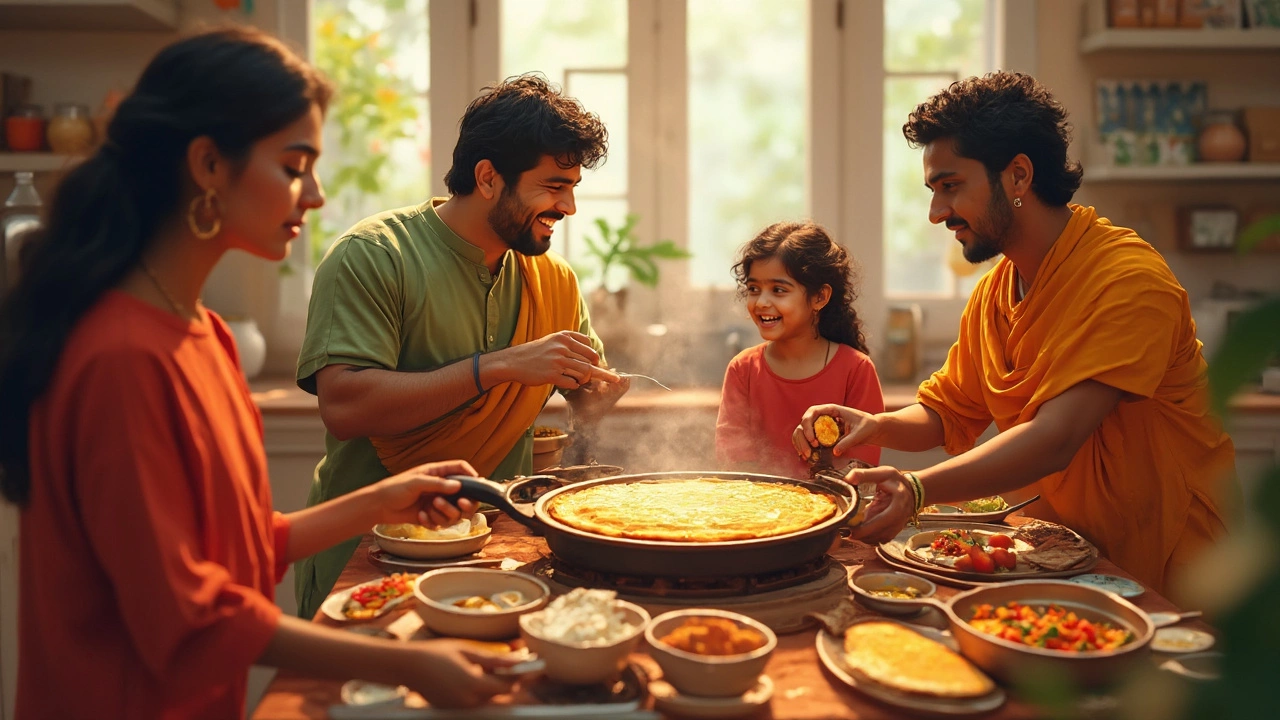Ever think of dosa as comfort food for the soul? That golden, crispy, paper-thin delight rolling around a soft, warm filling — it’s just hard to resist. But what if you’re hooked and want it every single day? Could dosa possibly be too much of a good thing? Or can you actually eat dosa every day without guilt? The answer isn’t just a simple yes or no. It has a lot to do with what lands on your plate, how it’s made, and the rest of what you eat.
What’s Inside a Dosa: The Nutritional Breakdown
Dosa, at its heart, is a fermented crepe made from rice and urad dal (black gram lentils). This might sound basic, but the magic is hidden in the mix of ingredients and the fermentation process. Let’s talk facts: a plain dosa has about 133 calories, a couple of grams of protein, almost no sugar, and less than 1.5 grams of fat. About 75% of those calories come from carbs, but complex carbs — not the instant, sugar-rush kind.
The urad dal in dosa isn’t just a protein source; it brings dietary fiber, calcium, magnesium, potassium, and B vitamins to the table. Fermentation, which dosa batter goes through for up to 12 hours, plays its own power moves. It breaks down phytic acid (the anti-nutrient that slows nutrient absorption), boosts vitamin B content, and helps your gut health by enriching the batter with live cultures.
Not every dosa looks the same. The traditional one is all about rice and urad dal, but there are so many versions across India — ragi dosa (finger millet), oats dosa, quinoa dosa, or buckwheat dosas. These swaps dial up fiber, iron, antioxidants, and protein, and they bring a lower glycemic index too. That’s a big deal if you’re watching your blood sugar or aiming for weight management.
Ever wondered how the count stacks up? Here’s a quick snapshot in a handy table that covers the basics per one plain dosa (around 60g):
| Nutrient | Amount (per dosa) |
|---|---|
| Calories | 133 kcal |
| Protein | 3 g |
| Carbohydrates | 25 g |
| Fat | 1.5 g |
| Fiber | 1 g |
| Calcium | 9 mg |
| Potassium | 40 mg |
Notice something? While dosa packs carbs—and yes, you need energy—it can be a lean, low-fat meal if you keep things simple and don’t splash on tons of oil. Even better, dosa hardly contains cholesterol unless you start stuffing it with butter or cheese. The trick is all in the toppings and the fillings.
An important note: dosa offers some protein, but it’s modest, so pairing it with protein-rich sides like sambar (lentil stew), paneer, or egg makes a big difference for fullness and nutrition.

Should You Eat Dosa Every Day? Balance, Benefits, and Watch-Outs
Eating dosa every day doesn’t sound wild, especially if you grew up in South India or just love a good breakfast. Can I eat dosa every day? Technically, yes, but it depends on a few things. Your health goals, portion control, cooking method, and what you pair it with will decide if daily dosa is a healthy habit or a heavy one.
The best part about dosa is the fermentation. Fermented foods help your gut with good bacteria, which boosts immunity, improves digestion, and can lower cholesterol. Those with mild lactose intolerance sometimes find fermented foods (like dosa batter) easier to process.
If you’re using stone-ground rice and urad dal, you’re scoring not just flavor but nutrients too—zinc, iron, antioxidants, even improved protein absorption. Most of the carbs in dosa are resistant starch, which means they don’t spike your blood sugar as fast as white bread or sugary cereal.
But dosa’s not perfect. White rice is mostly fast-digesting starch, and traditional dosa (if you eat it plain every day) isn’t a complete protein or high in fiber. If you make it with lots of oil or always go for masala dosa stuffed with ghee-laden potatoes, the calories add up, and so does the fat.
Here are situations where you might want to rethink an everyday dosa plate:
- If you have diabetes, the high-carb, low-fiber combo of regular dosa with potato filling can spike blood sugar. Try adding more lentils or millet, or stuffing it with sautéed veggies instead.
- If you’re aiming to lose weight, massive portions (or too much oil) are not your friend. Two large dosas with heavy fillings can easily cross 500 calories.
- For people with gluten intolerance or celiac disease, dosa is naturally gluten-free, so that’s a win. But always check restaurant batter for wheat additives.
- If you have kidney issues and need to watch your protein or potassium, urad dal can be high on both counts—talk to your doctor for tweaks.
Many dieticians agree dosa is an easy fit for a balanced vegetarian diet if you round it out with sambar, chutney, eggs, sprouts, or a glass of buttermilk. Ragi dosas can ramp up your calcium, bajra (pearl millet) dosas keep you full, and multigrain batters pack more fiber and minerals. It’s all about mix and match, not mindless repetition.
Another plus side: dosa never gets boring! You can change up your chutneys (tomato, coconut, mint, peanut), your sambar, the fillings inside. Even a basic dosa can taste totally different with a little imagination.

Making Dosa Healthier: Tips, Tricks, and Variations
Ready to turn your dosa routine into a nutrition win? Start at the base — your batter. Instead of all white rice, add brown rice, rolled oats, ragi, or sprouted moong dal. Every swap adds extra nutrients, slashes the glycemic index, and gives a flavor twist you won’t get bored of.
If you’re prepping batter at home, use minimal oil in your nonstick pan. A traditional dosa needs just a swipe of oil or ghee for that perfect crisp. Commercially made or restaurant dosas, on the other hand, are often swimming in oil for speed and crunch. Don’t be shy to ask for “less oil” or “no butter” next time you eat out.
Next, give the fillings a glow-up. Sure, the masala potato is classic, but why not try protein-rich paneer bhurji, spicy mung sprouts, mixed veggies, spinach and corn, crumbled tofu, or even an egg? These swaps pump up protein, keep you full longer, and won’t cause your energy to crash by noon.
Your choice of sides can level up your dosa instantly:
- Sambar: This lentil-based stew brings about 50-70 calories per ladle, tons of plant protein, and plenty of fiber from the veggies. More sambar equals fuller stomach and balanced nutrients.
- Chutneys: Coconut, tomato, coriander, peanut, or mint chutney can be healthy in moderation. Go easy on coconut chutney if heart health or cholesterol worries you, since coconut is high in saturated fat. Tomato and mint are lighter options.
- Yogurt: A small bowl of curd or buttermilk on the side gives probiotics and protein, great for digestion and satiety.
Here are a few game-changing habits for everyday dosa-lovers:
- Experiment with at least two varieties of flour or lentil in your batter each week — the more diversity, the better your micronutrients.
- Use cast iron if you want a natural iron boost — dosas cooked this way can actually help with anemia prevention!
- Add grated veggies like carrots, beets, or greens directly to your batter for a sneaky veggie intake.
- If time’s tight, keep some instant dosa batter mixes (made from millet or oats) on hand — just read the labels for excess preservative content or sodium.
- Eat dosas with a side salad or handful of roasted chickpeas to balance the macros.
And don’t stress if you skip a day or crave something else. Dosa isn’t about rigid rules or bland repetition — it’s about tradition, taste, and sometimes, comfort. So yes, you can eat dosa every day if you play it smart, switch up the grains and lentils, load it with veggies and wholesome sides, and don’t drown it in oil or processed cheese. Keep it real, keep it balanced, and dosa will pretty much love you back!
